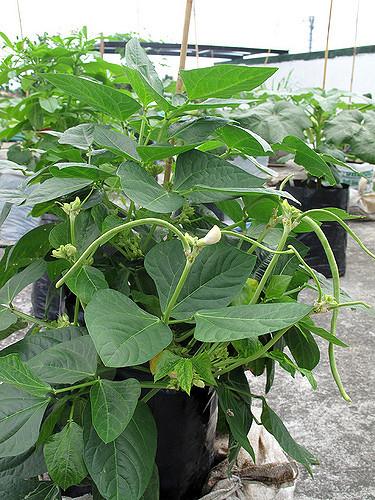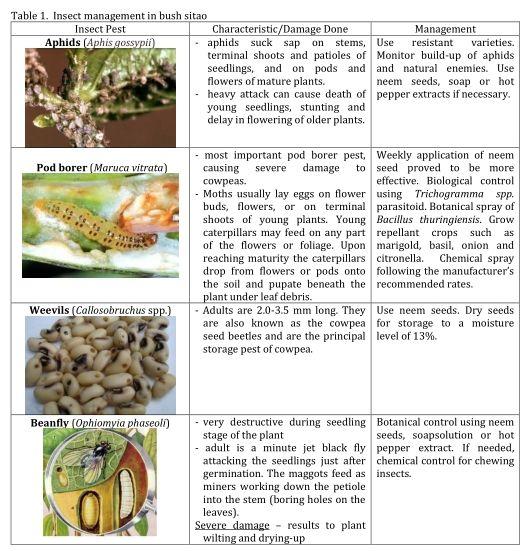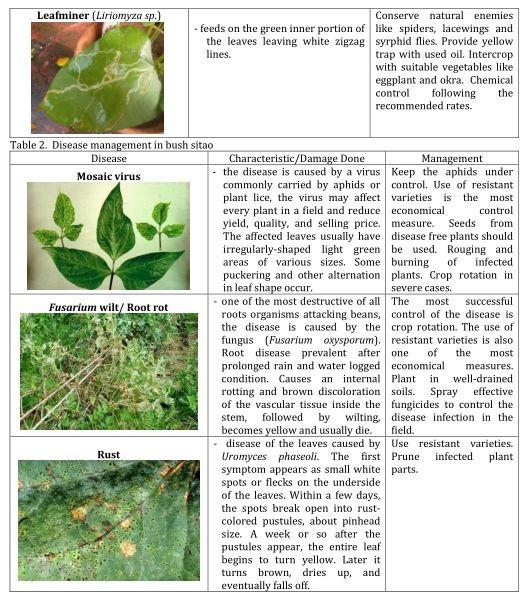Bush sitao (Vigna sesquipedalis x Vigna unguiculata) belongs to the Fabaceae family. The crop is still minor in the Philippines since being planted only in small scale farming and in the backyards. Bush sitao i often times grow either as an intercrop or in rotation with other upland crops. Based from the production data of the Bureau of Agricultural Statistics (BAS), about 11,381 hectares were utilized for vegetable legume crops including bush sitao in 1995 with estimated production of 29,058 metric tons.

It is a cross between pole sitao and cowpea which possesses the combined good qualities of the two. The crop is bush-type, doesn’t need a trellis, less susceptible to wind damage and easier to manage than pole sitao. This crop provides income to farmer when sold on open market.
Bush sitao is an annual dry season crop and takes a short period of time to grow. It may be erect,trailing, climbing, and usually indeterminate under favorable conditions. The leaves are trifoliate and are usually green in color. It is a self-pollinating crop. Flower colors are white, dirty white, pink, pale blue or purple. Flowers open in e morning and close in mid-day and after blooming they wilt and collapse. Th stems are straight, smooth or slightly hairy and sometimes tinged with purple. The pods are borne above the leaf canopy making the pods very visible. The seeds vary in size, color and shape. Usually the number of seeds per pod varies from 8-20 seeds. The pods may be erect, crescent-shaped or slightly curved.
It is an important crop among home gardeners and has been released as substitute for pole sitao. It is a fast growing crop, bears more pods that are more tender and fleshy. It matures earlier and can b grown the whole year round. The plant tolerate drought, performs well in any type of soil however, friable fertile soil is preferred to obtain healthy growth and high quality pods.
Bush sitao is also a good source of plant protein and consumed as vegetables either cooked or mixed with other foods. It is also utilized as green manure to improve soil conditions. It is also a good source of feeds in the form of silage or forage.
CROP VARIETIES
Among the open pollinated varieties of bush sitao are BPI-Bs #1, BPI-Bs #2 and PSB-Bs #3 (Figure 1). PSB-Bs #3 is recommended for its good pod quality, light green color, longer pod length (24.4cm), early maturing and has an average yield of 8.96 t/ha. This variety is also moderately resistant to pests and diseases. This variety is available at BPI-LBNCRDC.
CULTURE AND MANAGEMENT
1. Soil and climate requirement. Bush sitao thrives in areas with fertile and well drained sandy loam soil. It is a warm season crop and can be grown throughout the year provided water is available. During dry season, weekly irrigation is recommended but water logging must be avoided during wet season because it induces pod rotting and causes root rot.
2. Land Preparation. Though land preparation is important to obtain high yield since the operation renders the soil ideal for seed germination resulting to high plant stand and will ensure healthy and uniform growth of bush sitao crop.
Prepare the land by alternately plowing and harrowing the field 2-3 times. The use of beds is recommended during the rainy season; however furrow method is still preferred because bedding is laborious. During dry season planting, prepare the furrows 60cm apart and 75cm for wet season because this crop becomes viny during this season.
3. Varietal Selection – Planting right varieties adapted to a specific area may increase yield by as much as 20%. In the varietal selection, there are important considerations to look into:
a. Adaptability to soil and climate
b. Maturity
c. Yield
d. Disease resistance and insect tolerance
e. Market/consumers demand
.
4. Planting. Bush sitao can be planted the whole year round. Provided irrigation is available, better performance of the crop is observed when grown in January. The seeds are directly sown in the furrows. One hectare requires 10-12 kg of seeds. Drill the seeds in furrows at the rate of 15-20 seeds per linear meter. Thin out the seedlings 10 days after emergence.
5. Fertilization. Before the first plowing, apply 3 tons of well decomposed manure per hectare. Before planting, apply 3 bags/ha of 14-14-14 as basal fertilizer and side dress with 1-2 bags of urea (46-0-0) at 1 month after planting. Muriate of potash (0-0-60) should be applied at the rate of 1-2 bags during flowering stage. Foliar fertilizer should also be applied weekly, starting at flowering stage.
6. Organic fertilizer: Fertilizer should be bio-degradable materials of microbial, plant or animal origins produced on organic farms such as vermicompost and processed chicken manure. Basal applications organic compost of 5-10 tons/ha are needed for vegetable legume crops. Supplementary application of Fermented Plant Juice (FPJ) or Fermented Fruit Juice (FFJ) should also be applied twice a week up to flowering stage.
7. Weeding and Cultivation. Off-baring and hilling-up can be done early as two (2) weeks. Hand weeding shall be done as often as necessary. Even after flowering, spot weeding is still of much benefit to the crop. The common methods are hand pulling, hoeing and the use of animal-drawn native plow. Best results are achieved by using a combination of these methods.
8. Irrigation. The field should be irrigated right after planting or whenever necessary using manual watering to have a uniform germination of seeds During dry season, weekly irrigation is recommended. Adequate application of water is necessary during flowering and early fruiting stages to obtain high percentage of pod setting.
PEST AND DISEASE MANAGEMENT


For effective control, use resistant varieties and other measures like crop rotation, rouging and pruning of infected plant parts and planting of repellant and companion crops, and if needed, the use of chemicals/fungicides will be the last resort in controlling pests and diseases of bush sitao.
HARVESTING
For use as vegetable, pods are harvested 40-45 days after emergence. Harvesting should be done at 2-3 days interval to prolong the productive life of the plants. Harvesting is done manually. Harvest the pod by holding the stem end before twisting it free. To avoid weight loss, harvesting should be done early in the morning or during the cooler times of the day. The pods should be kept in a shaded area after harvest.
POST HARVEST HANDLING
Separate the marketable and non-marketable pods. Marketable pods are tender, straight, long and unblemished. Non-marketable pods are short, curved, damaged with insects or diseases and over the picking stage but can still utilized as vegetable.
Packing
Pack in plastic sacks, thick lined bamboo baskets, polyethylene bags or wrap the harvested pods with fresh banana leaves. If bush sitao pods cannot be sold or used for 1-3 days, store small quantities in moistened clay jars. Store pods at 12-15 o C for not more than 2 weeks at 90% relative humidity if cold storage facilities is available. Keep the pods away from ripening fruits during transport and storage.
SEED PRODUCTION
Except for isolation and rouging, the cultural management techniques in seed production are similar to fresh pods production.
A. Isolation. The isolation distance depends on the nature of pollination of the crop, whether self or cross pollinated. The isolation distance of bush sitao is 10-50 meters.
B. Field Inspection. It involves identification of a variety and removal of undesirable plants from the main crop through a process termed rouging. The undesirable plants may be weeds, plant of other crop species, plants of another cultivar of the same species, diseased plants and other off-type plants.
Rouging should be done at least three times: first at pre-flowering stage; second at flowering; and third at pod formation.
C. Harvesting. Select plants that is vigorous and free from pests and diseases. Harvest pods when physiologically mature or when pods have turned brown. Harvested pods at 20 days after pollination will give the best quality seeds. It may be necessary to harvest 3 times a week at peak harvest. Dry pods should not be allowed to remain in the field to prevent shattering during sunny days rotting or sprouting of seeds within the pods during the rainy days. When dry pods remain longer in the field, these are also being exposed to insect pests.
Place the harvested pods under the sun for 2-4 days until brittle. Threshing is carried on by beating the pods enclosed in net bags or sacks and manually beat with a stick. Separation of seeds from threshed pods is done by winnowing. Sort out small, wrinkled and seeds damaged by insect. Sun dry the seeds for 4-5 days. Before packaging and storage, seeds must have 10% moisture content (MC). Seeds must be packed in thick plastic, containers or aluminum foil, label with the name of the variety and date of planting then keep in a cool or storage area. In the absence of cold storage, seeds can also be stored in the refrigerator. If properly stored, viability of the seeds becomes longer.
References:
BAS. Vegetable Production Data (1991-1995). Bureau of Agricultural Statistics, Quezon, City.
Carada, V.B.October 1986. Plant Industry Production Guide (26). Cucumber and Vegetables Legumes. Bureau of Plant industry.
Calingasan, M.K. August1999. Paper presented to the participants of the Vegetable Seed Production
Technology at the Agricultural Training Institute- Farmers Training Center.
en.wikepedia.org/wiki/Helicoverpaarmigera
Fliers. Bush Sitao. Department of Agriculture. Bureau of Plant Industry, Los Baños National Crop Research and Development Center.
Fliers. Production Guide of Pole Sitao. PCARRD. Department of Science and Technology. Information Bulletin No. 154-A/2009.
http://www.infonet-biovision.org/default/cct/81/pests
http://www.infonet-biovision.org/default/cct/99/pests
http://www.infonet-biovision.org/default/cct/120/pests
How to Farm Better. Published by: Asian Rural Life Development Foundation, International.
Department of Agriculture- Bureau of Plant Industry
